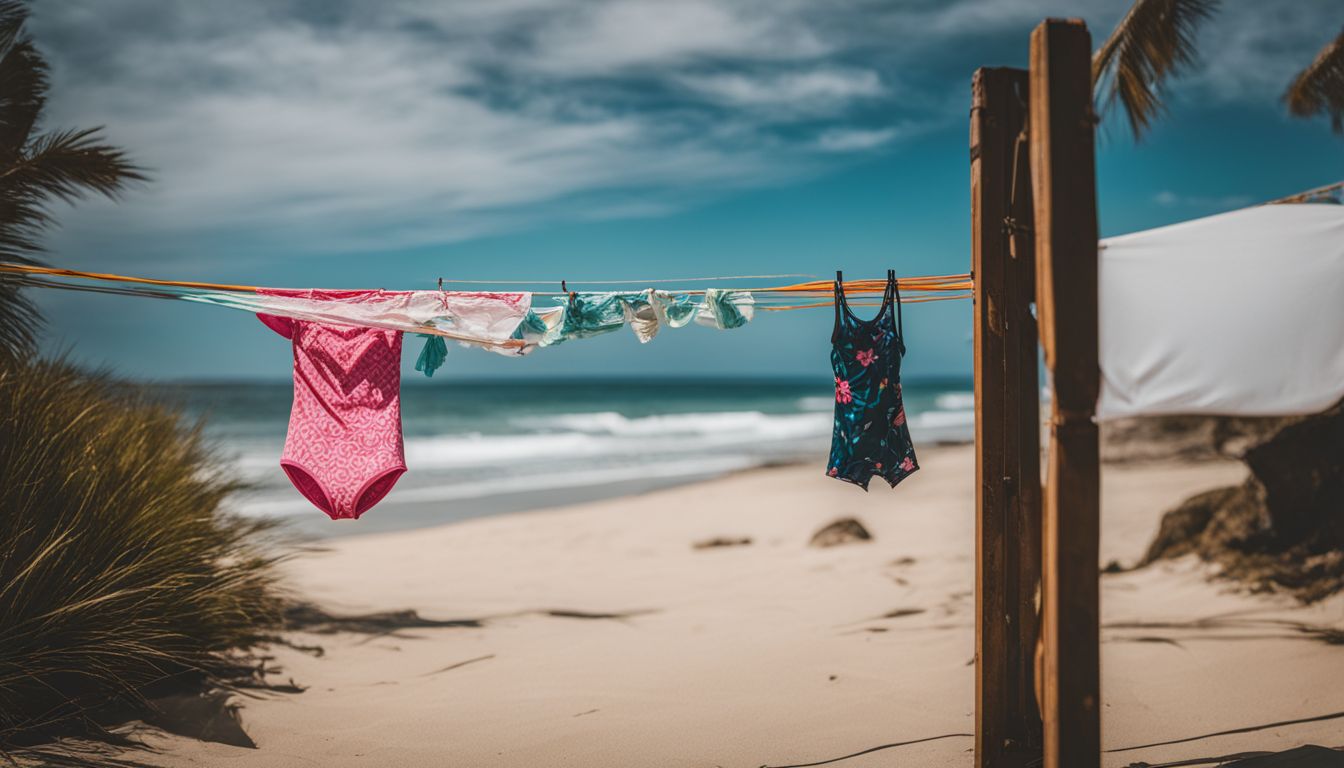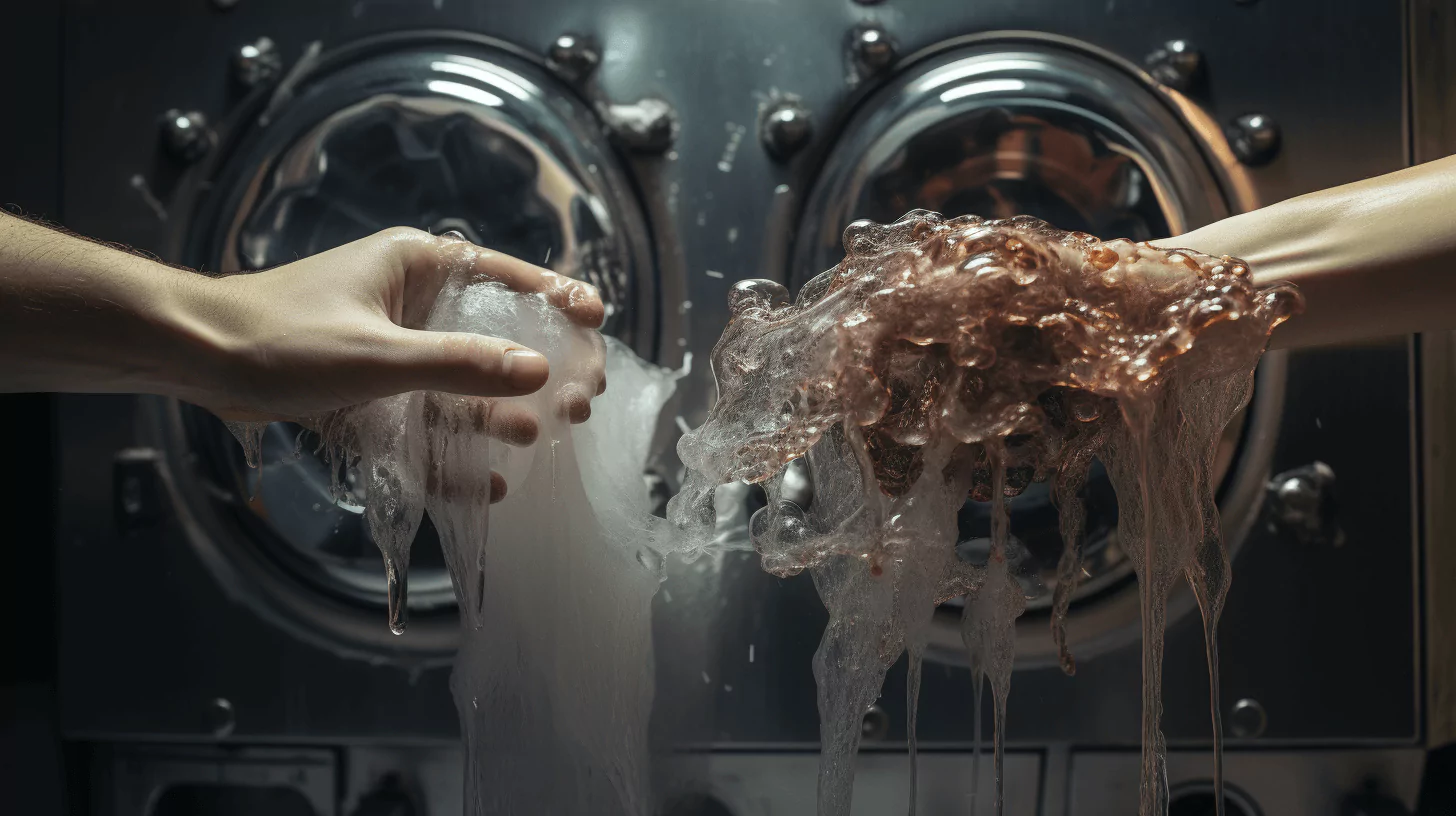How to Wash Swimming Costume the Right Way
Swimming costumes are often one of our favourite summer essentials, but do you know how to properly wash them to maintain their colour and shape? According to The Laundress, using cold water and a gentle cycle can significantly prolong the life of your swimwear.
This article will provide step-by-step instructions on how best to cleanse your swimming costume, from rinsing it immediately after use to choosing the right detergent. Keep reading for our detailed guide; you’ll thank us when your swimsuit still looks new by next summer!
Key Takeaways
- Rinse your swimming costume with cool water after each use to remove chlorine, salt, and chemicals that can damage the fabric.
- Choose a gentle detergent specifically designed for swimwear when hand washing or machine washing your swimsuit.
- Air dry your swimsuit in a cool and shaded area to prevent fading and stretching. Avoid using a dryer or ironing as they can damage the fabric.
- To remove stains and odors, gently scrub the affected area with baking soda or mild detergent before rinsing thoroughly with cool water. Consider using natural methods such as white vinegar or charcoal to eliminate odors without damaging the fabric.
Why Proper Care for Your Swimming Costume Matters
Taking good care of your swimming costume keeps it looking new. It also lasts longer. Sun, salt and sand can harm your costume. You need to clean it in the right way to protect it.
A quick rinse with fresh water gets rid of harmful saltwater. This stops any fading of bright colours.
Using hot water can hurt the colour and shape of your swimwear. Cold water is safe for washing and rinsing costumes at all times. Scrubbing the inside part helps to keep the outside fabric looking new for a long time too! Plus, drying off your swimsuit well before you store it stops bad smells and mildew from growing.
The Common Mistakes People Make
You might be caring for your swimsuit the wrong way. Here are some things you may be doing wrong:
- You pop your costume in a washing machine.
- You use the delicate cycle on your machine to clean it.
- You choose hot water over cold or cool water for washing.
- You don’t rinse your costume as soon as you take it off.
- You fail to turn your swimsuit inside out before washing by hand.
- You don’t make use of mild or special soap when hand washing.
The Importance of Rinsing

Rinsing is a key step in caring for your swimsuit. Right after you get out of the pool or sea, give it a quick rinse with cool water. This can prevent skin oils, sunscreen and chlorine from sitting on your suit too long.
These things can harm the fabric over time.
It’s also very important to wash off the salt if you’ve been swimming in the sea. Salt can dry out and damage your swimwear’s fabric. It’s best to rinse your swimsuit every time you wear it.
This will keep it looking great for longer! So, always remember to rinse right after use as this helps remove damaging stuff like sand, sweat and sun cream residue from soaking into the material of your swimming costume.
Why Rinsing is Crucial
Rinsing your swimsuit is a key step. It removes bad stuff like salt, sand, and harsh pool chemicals from the fabric. Do this right after you swim to keep these things from hurting your suit over time.
You help your bathing suit last longer and look good by doing a quick rinse with fresh water each time you wear it in the pool or sea. This kind way of caring helps keep its shape and bright colors too! So, always make sure to rinse your swimwear thoroughly right after swimming.
The Best Time to Rinse Your Swimsuit
As soon as you come out of the water, rinse your swimsuit. Do this each time you swim. Use cool water to keep your swimsuit in good shape. A sink filled with fresh running water works well for rinsing.
Don’t wring it! This hurts the fabric and shortens the life of your swimming costume. So, care for it well by rinsing right away every time you wear it.
Hand Washing vs Machine Washing

Hand washing is great for your swimsuit. It’s kind and stops it from stretching. Always look at the label on your swimming costume first. Most say to hand wash them. Use mild detergent and cool water for this.
You can use a washing machine too. Some machines have special settings for delicate items like swimwear. Just take care with your suit! Flip it inside out before you put it in the machine to keep the colours bright.
With either method, make sure to rinse your swimsuit well to remove all soap or detergent.
The Pros and Cons of Each Method
Deciding whether to hand wash or machine wash your swimming costume can be a tricky decision. Both methods have their advantages and disadvantages, which we’ve outlined below:
| Hand Washing | Machine Washing | |
|---|---|---|
| Pros | Hand washing is gentle on the swimsuit and can prevent damage to delicate fabrics. It can be particularly effective when using a small amount of detergent in a warm bath and agitating the water as mentioned in the important facts. It ensures the elasticity and colour retain their quality. | Machine washing is quick and convenient. Washing the swimsuit with similar materials can prevent potential damage. A great option for those with limited time. |
| Cons | Hand washing can be time-consuming and labor-intensive. It may not thoroughly clean the swimsuit if not properly done. | Machine washing can be harsh on swimsuits, leading to possible fabric and elasticity damage. It can also lead to colour fading if not washed in cold water. |
Remember, the method you choose will depend largely on your personal lifestyle, the type of swimsuit, and the care instructions provided by the manufacturer.
Special Detergents for Swimsuits
Using special detergents formulated for swimsuits is highly recommended when washing your swimwear. These detergents are designed to effectively remove chlorine, salt, and other chemicals that can damage your swimsuit.
They also deodorize and reduce bacteria, ensuring that your swimsuit stays fresh and clean. If you don’t have access to a special detergent, you can use hand soap or even distilled white vinegar as emergency alternatives.
Liquid detergents like Persil ProClean Original Scent are preferred for hand washing swimsuits. So make sure to invest in a good swimsuit detergent or find suitable alternatives to keep your swimwear in great condition.
Drying Techniques
To keep your swimsuit in great shape, it’s important to dry it properly. Avoid drying your swimsuit in direct sunlight as it can fade the colors and damage the fabric. Instead, lay it flat in a cool and shaded area to dry.
Heat can be harmful, so never put your swimsuit in the dryer or use an iron on it. It’s also crucial to make sure that your swimsuit is completely dry before storing it to prevent mildew from forming.
By following these drying techniques, you can help prolong the life of your swimsuit and keep it looking its best for many seasons to come.
Why Air Drying is the Best
Air drying is the best way to dry your swimsuit. Direct sunlight can make the fabric fade, so it’s important to keep them away from the sun. After washing, roll your swimsuit in a towel to absorb excess water, then hang it or lay it flat in an area with good air circulation.
Let it dry for 24 hours to regain its shape. Avoid using a dryer as high temperatures can weaken and stretch the fabric. Air drying will help your swimsuit last longer and keep its vibrant color intact.
The Risks of Using a Dryer
Putting your bathing suit in a dryer can be risky. The heat from the dryer can damage the material and make it lose its shape. The elastic in the straps or waistband of your suit could also get damaged by the heat.
Using the dryer frequently can ruin the fabric of your bathing suit over time. Another important thing to note is that if you wash clothes with underwear in them, it can spread bacteria in the dryer, which could contaminate other items you put in there.
So, it’s best to avoid using a dryer for your swimsuit altogether.
Dealing with Stains and Odors
To deal with stains and odors on your swimsuit, it’s important to act promptly. If you have sunscreen or oil stains, pretreat them by gently rubbing the affected area with a mild detergent before washing.
For odors, soak your swimsuit in a solution of half a cup of baking soda and cool water for about 30 minutes. This can help eliminate any unpleasant smells and brighten the colors of your swimsuit.
After soaking, rinse it thoroughly with cool water.
When washing your swimsuit, always use cold water instead of hot water. Hot water can cause colors to fade and elasticity to weaken over time. It’s also best to avoid using chlorine bleach as it can damage the fabric.
Instead, opt for a gentle detergent specifically made for delicate garments like swimwear.
When dealing with stains or scrubbing away dirt, make sure to use a soft brush or sponge to avoid damaging the fabric. Gently scrubbing should be enough to remove most stains without causing any harm.
Remember that proper care is essential in maintaining the appearance and longevity of your swimsuit. By following these tips for dealing with stains and odors, you can keep your swimwear looking fresh season after season.
How to Remove Sunscreen and Oil Stains
To remove sunscreen and oil stains from your swimsuit, follow these simple steps:
- Wet the stained area of the swimsuit.
- Sprinkle baking soda onto the stain and gently rub it in.
- Apply a small amount of gentle detergent or soap to the stain.
- Use a sponge or soft cloth to gently scrub the stain in a circular motion.
- Rinse the swimsuit thoroughly with cool water, making sure all the detergent is washed away.
- If the stain persists, create a mixture of distilled white vinegar and water (equal parts) and apply it directly to the stain.
- Let the vinegar mixture sit on the stain for about 10 minutes, then rinse again with cool water.
Natural Ways to Eliminate Odors
Swimwear can sometimes develop odors, but there are natural ways to get rid of them. Here are some tips:
- Use white vinegar: Add a cup of white vinegar to a sink filled with cool water and let your swimwear soak for 30 minutes. Then rinse it thoroughly and air dry.
- Try baking soda: Sprinkle half a cup of baking soda over your swimwear and let it sit for 15-20 minutes. Then rinse well and air dry.
- Consider charcoal: Charcoal is known for its odor-absorbing properties. Place an activated charcoal sachet or pouch in a storage bag with your swimwear to keep it smelling fresh.
- Don’t forget sunlight: Direct sunlight can help eliminate odors from swimwear naturally. After washing, place your swimwear flat to dry in the sun if possible.
How to Remove Sand
To remove sand from your swimsuit, start by shaking off as much sand as possible when you take it off. This will help loosen any stuck particles. Next, rinse your swimsuit with cold water.
The cold water will help wash away the sand without setting it in further. You can also try soaking your swimsuit in a bucket of cold water mixed with a mild detergent like Soak, which is specifically designed for delicates and swimwear.
After soaking for about 30 minutes, gently squeeze the fabric to agitate the water and loosen any remaining sand. Finally, thoroughly rinse your swimsuit with cold water and air dry it flat to prevent any leftover sand from sticking to the fabric.
By following these steps, you can keep your swimsuit clean and free from annoying sand particles!
Quick Tips for Beach-goers
Heading to the beach? Here are some quick tips to keep your swimsuit looking great:
- Rinse your swimsuit with cool water as soon as you leave the beach.
- Avoid sitting on rough surfaces that could snag or weaken the fabric.
- If you have sunscreen or sweat stains, pretreat them before washing.
- Use a gentle detergent and wash your swimsuit by hand or in a machine on a delicate cycle.
- Never use chlorine bleach, as it can fade and stretch your swimsuit.
- After washing, air – dry your swimsuit flat to help it keep its shape.
- Store your bathing suits in a cool, dry place away from direct sunlight.
- Check the label for specific care instructions for your swimsuit.
The Do’s and Don’ts
Do:
- Rinse your swimsuit with cool water after every use to remove chlorine, salt, and sweat.
- Hand – wash your swimsuit in cold water using a gentle detergent for best results.
- Gently squeeze out excess water from your swimsuit before drying.
- Air dry your bathing suit by laying it flat or hanging it up in the shade.
- Pretreat stains with a mild detergent before washing to prevent them from setting.
- Store your swimsuit in a cool, dry place away from direct sunlight.
- Soak your swimsuit overnight as it can weaken the fabric and cause it to lose its shape.
- Leave a wet swimsuit balled up or stored in a plastic bag, as this can lead to mold and mildew.
- Use high temperatures or chlorine bleach when washing your swimsuit, as these can damage the fabric and fade colors.
- Wring out your swimsuit, as this can stretch and damage the elastic fibers.
- Sit on rough surfaces while wearing your swimsuit, as this can snag the fabric and cause pilling.
- Ignore specific care instructions on the label of your swimsuit; different fabrics may require different care methods.
Storage Solutions
To keep your swimsuits in the best condition, it’s important to store them properly. One key tip is to avoid putting a wet bathing suit in a drawer or storage container, as this can lead to mold and mildew growth.
Instead, make sure your swimsuit is completely dry before storing it. Using specialized storage containers or bags can also help protect your swimsuits from dust and damage while they’re not being worn.
By taking these simple steps, you can ensure that your swimwear stays fresh and ready for the next time you hit the beach or poolside.
Best Practices for Storing Your Swimsuit
To keep your swimsuit in good condition, follow these best practices for storing it:
- Make sure your swimsuit is completely dry before storing it. Excess moisture can lead to mold and mildew growth.
- Avoid folding your swimsuit as much as possible, as this can cause creases and damage the fabric. Instead, store it flat or hang it up.
- If you choose to hang your swimsuit, use a padded hanger or a clothespin to avoid stretching out the straps or causing any other damage.
- Store your swimsuit in a cool, dry place away from direct sunlight. Sunlight can cause colors to fade and elastic fibers to weaken over time.
- Consider using a garment bag or a zippered plastic bag to protect your swimsuit from dust, dirt, and potential snags.
- Keep your stored swimsuits separate from other clothing items to prevent any transfer of dyes or chemicals.
How to Keep Your Swimsuit Fresh During Off-Season
To keep your swimsuit fresh during the off-season, there are a few simple steps you can follow. First, make sure to thoroughly rinse your swimsuit after each use. This helps remove any chlorine or salt water that may be trapped in the fabric.
Next, avoid storing your swimsuit in direct sunlight as this can cause fading. Instead, choose a cool and dry place to store it. If you notice any stains or odors on your swimsuit, pretreat them before washing using mild detergent and cold water.
Finally, adding white vinegar to the wash can freshen and deodorize your swimsuit during the off-season. By following these tips, you’ll be able to keep your swimsuit looking great all season long!
Additional Tips
To keep your swimsuit in top condition, there are a few additional tips to consider. Firstly, avoid using fabric softeners as they can damage the elasticity of your swimsuit. Instead, opt for a mild detergent specifically designed for swimwear.
Additionally, it’s important to rinse your swimsuit thoroughly after each use to remove any chlorine or saltwater residue. When storing your swimsuit, make sure it is completely dry before putting it away and avoid folding or wringing it, as this can cause wrinkles and stretching.
Lastly, be mindful of how often you replace your swimsuit. Over time, chlorine and other chemicals can weaken the fabric and cause fading or loss of shape.
When caring for your swimming costume , remember not to use fabric softeners as they may affect its elasticity. Rinsing after every wear is crucial too. Use mild detergent made specially for swimwear , rinse thoroughly afterwards.
Store when fully dried ; do not fold or wring the suit else wrinkles will develop instead just flat store them. Also take note on how frequent you should replace the costume since over time chlorine will affect its quality .
Fabric Softeners: Yay or Nay?
Fabric softeners can be a bit controversial when it comes to washing swimwear. While they can make clothes feel softer and smell nice, they may not be the best choice for your swimsuit.
This is because fabric softeners can damage certain fabrics like swimwear, which is often made of polyester or other synthetic materials. Using fabric softener on these types of fabrics can ruin the elasticity and shape of your swimsuit over time.
Instead, consider using alternatives like vinegar or baking soda to freshen up your swimwear without causing any harm.
How Often Should You Replace Your Swimsuit?
Swimsuits are not meant to last forever, and eventually, you’ll need to replace them. How often you should get a new swimsuit depends on how frequently you wear it and how well you take care of it.
Ideally, experts suggest replacing your swimsuit every one to two years for the best fit and performance. However, if you swim regularly or expose your swimsuit to chlorine or saltwater often, it may need more frequent replacement.
Signs that it’s time for a new swimsuit include stretched-out elastic, faded colors, pilling fabric, or loss of shape. Taking proper care of your swimsuit can help extend its lifespan but remember that even with great care, all good things must come to an end!
Conclusion
To keep your swimming costume looking its best, remember these important steps. Start by rinsing it in cold water after each wear to remove chlorine and salt. Hand washing is the gentlest method, but if you prefer machine washing, use a delicate cycle with a gentle detergent specifically designed for swimwear.
Avoid using hot water or bleach as they can damage the fabric. Always air dry your swimsuit away from direct sunlight to prevent fading and stretching. By following these tips, you can ensure that your swimming costume stays clean and ready for your next dip in the pool or beach adventure!
Summary of Key Points
- Proper care for your swimming costume is important to maintain its quality and appearance.
- Rinse your swimsuit with tap water or mild soap after each use to remove chlorine or salt water.
- Hand washing your swimsuit is preferable to using a washing machine, as it can be too aggressive on delicate fibers.
- Use cold water when washing your swimsuit to prevent color fading and damage to elasticity.
- Gently squeeze out the water after rinsing, instead of wringing it, to avoid stretching the fabric.
- Dry your swimsuit in the shade to prevent direct sunlight from fading the colors and weakening the fabric.
- To remove stains and odors, pretreat with baking soda or white vinegar before washing.
- Avoid sitting on rough surfaces while wearing your swimsuit to prevent snags and damage.
- Store your swimsuits properly by hanging them or laying them flat to maintain their shape.
- Replace your swimsuit periodically to ensure optimal performance, especially if it has lost its shape or elasticity.
Remember, these tips will help you keep your swimwear looking great all season long!
Final Thoughts and Recommendations
To keep your swimsuit looking great and lasting longer, it’s important to follow proper care practices. Remember to wash your swimwear with similar materials and pretreat any stains before washing.
Be gentle when washing your suit and avoid agitating the water or wringing out the fabric. After washing, hang the swimsuit to dry instead of using a dryer, as high temperatures can weaken the fabric.
By following these recommendations, you can ensure that your swimsuit stays in good shape for many seasons of swimming fun.









